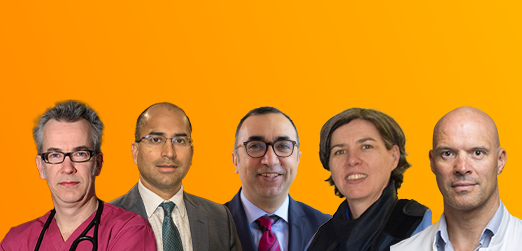- Home
- Vascular Interventions Online 2021 - Venous - Part 1
Vascular Interventions Online 2021 - Venous - Part 1
- Intervention
- Vascular
Available Credit:
- 2.00
Course Published On:
Course Expiry Date:

Overview
In this session, Venous – Part 1, part of Vascular Interventions Online 2021, a leading faculty discuss topics such as acute DVT and great saphenous vein recurrent reflux.
To further illustrate this, the event will feature a number of practical demonstrations in the form of live cases broadcast from cardiovascular centers, such as Stony Brook University.
This session also features live cases on chronic venous obstruction/acute DVT from Guy’s and St Thomas’ NHS Foundation Trust, London; as well as a live case on chronic deep venous disease from Erasmus MC, Rotterdam, NL.
Vascular Interventions Online (VIO) aims to educate vascular professionals, interventionalists and surgeons who are involved and/or interested in vascular interventional treatment with a focus on Aortic, Venous and PAD / Lower Limb.
Disclosure
In compliance with EBAC / EACCME guidelines, all speakers/chairpersons participating in this programme have disclosed or indicated potential conflicts of interest which might cause a bias in the presentations.
The Organising Committee/Course Director is responsible for ensuring that all potential conflicts of interest relevant to the event are declared to the audience prior to the CME activities
Terms & Conditions
Radcliffe Education requires contributors to our CME programmes to disclose any relevant financial relationships that have occurred within the past 12 months that could create a conflict of interest. These will be identified in the faculty section if applicable.
The session of ‘Vascular Interventions Online 2021 - Vascular interventions online – Venous – Part 1’ is accredited by the European Board for Accreditation in Cardiology (EBAC) for 2 hours of external CME credits.
Each participant should claim only those hours of credit that have actually been spent in the educational activity. EBAC works according to the quality standards of the European Accreditation Council for Continuing Medical Education (EACCME), which is an institution of the European Union of Medical Specialists (UEMS).
Through an agreement between the European Board for Accreditation in Cardiology and the American Medical Association, physicians may convert EBAC External CME credits to AMA PRA Category 1 Credits™. Information on the process to convert EBAC credit to AMA credit can be found on the AMA website.
Instructions to Participants
There is no fee for taking part in this online learning activity.
Activities are designed to be completed within 120 minutes and must be completed by the registered user. Physicians should only claim credits for time spent on the activity. To successfully earn credit, participants must complete the activity in full in the indicated time frame.
To complete the course and claim certification participants must:
-
Read the course outline information supplied and complete pre-test questions if supplied prior to starting the activity. Users must read and study the activity in its entirety before completing the post-test questions.
-
Your results will be automatically saved and if a pass score is achieved (where applicable), you may be eligible to claim credit for the activity and receive a certificate of completion.
Support Statement
This programme is supported by unrestricted educational grants from the following companies. The scientific programme has not been influenced in any way by the sponsors.
- Bentley
- Shockwave Medical
Target Audience
- Vascular professionals
- Interventionalists
- Surgeons who are involved and/or interested in Aortic, Venous, and PAD / Lower Limb
Learning Objectives
The overall programme, Vascular Interventions Online 2021, endeavours to best address the following learning objectives:
- To develop an understanding of available treatment strategies for challenging and difficult access procedures
- To update knowledge on the latest technological developments and options
- To gain insight into tips and tricks employed at leading international centres
Module |
Title |
Duration |
Speakers |
|---|---|---|---|
| Live Case | Chronic Venous Obstruction / Acute DVT | Hayley Moore (Guys and St Thomas NHS Foundation Trust, London, UK) Prakash Saha (Guys and St Thomas NHS Foundation Trust, London, UK) | |
| Presentation | Acute DVT | Kush R Desai (Northwestern University, Chicago, IL, US) | |
| Live Case | Chronic Deep Venous Disease | Marie-Josee Van Rijn (Erasmus University Medical Center, Rotterdam, the Netherlands) Adriaan Moelker (Erasmus University Medical Center, Rotterdam, the Netherlands) | |
| Presentation | Great Saphenous Vein Recurrent Reflux | Nicos Labropoulos (Stony Brook University Medical Center, Stony Brook, NY, US) |
Chronic Venous Obstruction / Acute DVT
Duration:
Speakers: Hayley Moore (Guys and St Thomas NHS Foundation Trust, London, UK) Prakash Saha (Guys and St Thomas NHS Foundation Trust, London, UK)
Chronic Deep Venous Disease
Duration:
Speakers: Marie-Josee Van Rijn (Erasmus University Medical Center, Rotterdam, the Netherlands) Adriaan Moelker (Erasmus University Medical Center, Rotterdam, the Netherlands)
Great Saphenous Vein Recurrent Reflux
Duration:
Speakers: Nicos Labropoulos (Stony Brook University Medical Center, Stony Brook, NY, US)
Chair
Panelist
Operator

















